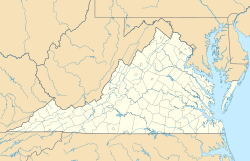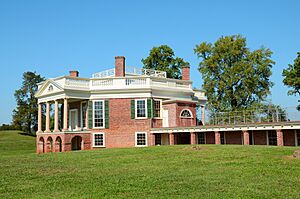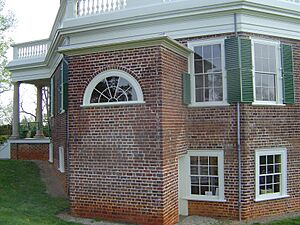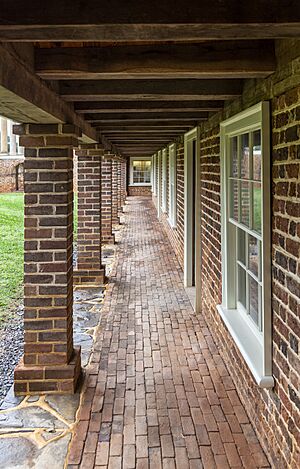Poplar Forest facts for kids
|
Poplar Forest
|
|
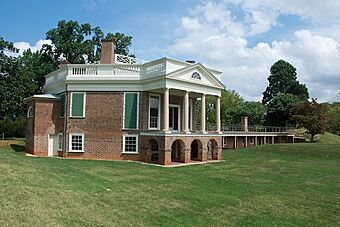
Poplar Forest, designed by Thomas Jefferson
|
|
| Location | 1776 Poplar Forest Parkway, Lynchburg, Virginia |
|---|---|
| Built | 1806–1826 |
| Architect | Thomas Jefferson |
| NRHP reference No. | 69000223 |
Quick facts for kids Significant dates |
|
| Added to NRHP | November 12, 1969 |
| Designated NHL | November 11, 1971 |
Poplar Forest is a special home in Forest, Virginia, USA. It was once owned by Thomas Jefferson, who was one of the Founding Fathers and the third U.S. president. Jefferson inherited this land in 1773. He started designing his private retreat home there in 1806.
Many people owned Poplar Forest before it was bought in 1984. This purchase was made to restore and protect the property. Today, Poplar Forest is a National Historic Landmark. It is run as a historic house museum by a non-profit group. This group also does archaeological digs and restoration work. The restoration of Jefferson's villa was completed in April 2023.
Contents
The Story of Poplar Forest
The land where Poplar Forest stands has a long history. Native American people lived there for thousands of years. This includes groups from the Paleo-Indian to the Late Woodland periods.
The 4,000-acre property was first officially owned by William Stith in 1745. He was a minister and planter. Stith did not live on the land. Ownership then passed to his daughter, Elizabeth Pasteur. She sold it to her cousin, Peter Randolph.
In 1764, John Wayles bought the property. He added 819 more acres by 1770. Wayles was the first to use enslaved people to work on the land. Like Stith, Wayles did not live at Poplar Forest. He was an attorney and businessman in Charles City County, Virginia.
Jefferson's Ownership
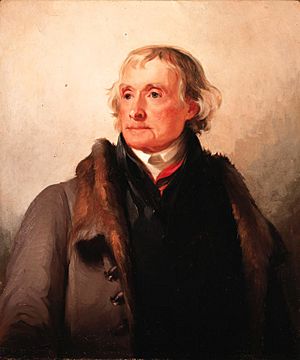
John Wayles' daughter, Martha Wayles Skelton, married Thomas Jefferson. They inherited the entire 4,819 acres when Wayles died in 1773. The Jeffersons did not immediately focus on Poplar Forest. They were busy building Monticello and raising their family. Thomas Jefferson also had a busy career in public service. He served as Minister to France and Secretary of State. He was also Vice President and President.
Even when Jefferson was away, the plantation made money. Enslaved people worked there under a steward and overseers. After 1790, they grew tobacco and wheat crops.
Jefferson visited Poplar Forest every year from 1810 to 1823. He often brought his granddaughters, Ellen and Cornelia Jefferson Randolph. He always traveled with enslaved men and women from Monticello. His visits lasted from a few days to a week.
Jefferson owned the property and the enslaved people until 1790. Then, he gave 1,000 acres and six enslaved families to his daughter Martha. She was married to Thomas Mann Randolph Jr. Randolph later sold much of Jefferson's land. He also sold many enslaved people to pay off debts.
Later Owners and Restoration
Near the end of his life, Jefferson wanted someone to live at Poplar Forest permanently. His grandson, Francis W. Eppes, and his wife moved there in 1823. Jefferson died in 1826. His last visit to Poplar Forest was in 1823.
The Eppeses sold Poplar Forest in 1828 to William Cobbs. Cobbs' son-in-law, Edward Hutter, managed the property from 1840. The Cobbs–Hutter family owned Poplar Forest for a long time. During this period, many enslaved families were separated when the property was sold. Christian Hutter, a son, bought the property later. He used it as a summer home and farm until the 1940s. He hired both Black and white farmhands.
In 1946, Christian Hutter sold the property to the Watts family. The Watts family ran a dairy farm there. They also worked to restore the house to how it looked in Jefferson's time. They sold much of the land to a developer. This developer built a golf course and a lake.
Dr. James Johnson bought the house and 50 acres in 1980. Then, in 1984, the non-profit Corporation for Jefferson's Poplar Forest bought the property. This group works to buy back land that was part of the original plantation. By 2008, they owned 617 acres. The corporation finished restoring Jefferson's villa in April 2023.
Architectural Design
Construction at Poplar Forest began in 1806. At this time, Jefferson was President of the United States. He oversaw the building from Washington, D.C.. Thomas Jefferson taught himself architecture. He was known for his work at Monticello and the Virginia State Capitol. He often used designs from ancient Roman and Greek buildings. He liked the classical architecture of Palladio from Italy.
Jefferson designed Poplar Forest as his personal escape. He chose the property because it was far from his busy public life.
The house is shaped like an octagon. It might have been the first octagonal house built in the United States. The house is made of brick. It has a central square room and three long octagonal rooms. There is an entry hall on one side. A skylight is in the central dining room. This dining room is a perfect cube, measuring 20 feet by 20 feet by 20 feet.
Jefferson also added covered porches with columns on the north and south sides. There were also stairwells on the east and west. Experts agree that Poplar Forest is a great example of octagonal symmetry. Jefferson's design shows his skill in algebra, geometry, trigonometry, and calculus.
Changes and Preservation
Over the years, different owners made many changes to the main house. The plantation's land also shrunk to just 50 acres. In 1845, there was a fire. The Cobbs and Hutter families rebuilt the house. They added an attic story for sleeping. This changed the inside layout. However, the original walls, chimney, and columns remained.
The Corporation for Jefferson's Poplar Forest used old building materials for restoration. They used heavy timber, hemp rope for windows, and iron hardware. They also used 19th-century building methods. For example, they burned limestone to make traditional mortar and plaster. The goal of the restoration is to make Poplar Forest look like Jefferson's original design.
Enslaved People at Poplar Forest
Enslaved men, women, and children lived and worked at Poplar Forest from 1766 until 1865. That is when slavery was officially ended in the United States. We know about the enslaved people and their work from old records and archaeological digs.
John Wayles used enslaved labor to build roads on the property. When Thomas and Martha Jefferson inherited the land, they also inherited 135 enslaved people. These people were from Poplar Forest and other areas. Wayles divided his property among his heirs. This meant enslaved families were often separated to pay his debts.
As Jefferson focused more on Poplar Forest, he brought more enslaved people there. They came from Monticello and other properties. Jefferson kept careful records of the enslaved people. These records show that between 28 and 95 enslaved people worked at Poplar Forest from 1774 to 1819. Jefferson bought and sold enslaved people during his ownership. For example, he sold 40 enslaved people from his properties in Bedford County, Virginia in the 1790s.
After Jefferson died in 1826, the Eppeses inherited the house, land, and several enslaved people. The Cobbs and Hutter families also used enslaved labor until slavery ended. Some formerly enslaved people continued to work for them as hired workers.
Work and Daily Life
Starting in 1790, the enslaved community at Poplar Forest grew tobacco and raised livestock for profit. Later, they grew wheat. Records show that enslaved people regularly tilled fields and dug ditches. They also worked six days a week. They were responsible for building and maintaining their own homes.
Scholars have found that enslaved people at Poplar Forest had their own system of trade. They were allowed a small plot of land to grow food. They could trade or sell these goods to other enslaved people, the owners, or outside markets. Archaeologists have found items like buttons, glass beads, and fancy buckles. These were likely used as money among enslaved people.
Documents from the 19th century show that there were many enslaved workers at Poplar Forest. William Cobbs often hired out enslaved people to other projects. Some enslaved individuals, like Lucy and Matilda, had access to money. They used it to buy items for the Cobbs/Hutter families. Edward Hutter also leased enslaved people to businesses and other planters.
Family Connections
Records show that by the 1790s, seven different enslaved families lived at Poplar Forest. Jefferson encouraged enslaved people to form common-law marriages. He recorded the birth dates of every enslaved child born there. He also gave a pot to women who married another enslaved person from Poplar Forest. Archaeologists have found pieces of these pots.
Jefferson kept records of family connections. These records show that multiple generations of families were enslaved at Poplar Forest. They also had relatives at other plantations in Virginia. The Cobbs family inherited an enslaved family that included Mary and her daughters Lucy and Matilda. Lucy and Matilda worked as house slaves.
Known Enslaved People
- Hannah worked at Poplar Forest from her teenage years until about 1821. She married and had a family. She could read and worked as Jefferson's housekeeper for a time.
- James (Jame) Hubbard was bought by Jefferson at age 30. He oversaw field laborers. He had six children with an enslaved woman named Cate. He also cared for several other children. Later, he worked as a hogkeeper. His family members, including Nace, Hannah, Nancy, Joan, James, and Phill, also worked at Poplar Forest.
- Phill was born at Poplar Forest to James Hubbard and Cate. He worked briefly at Monticello before returning to Poplar Forest. He married Hannah and had a son. He died at age 33, possibly from poisoning.
- William (Billy) was born at Poplar Forest. He resisted slavery by attacking an overseer more than once. Jefferson sent him and three others to Louisiana. William tried to run away but was caught and sold.
- John Hemmings never lived at Poplar Forest. However, records show he did much of the interior woodwork in the retreat house.
- Lydia Johnson lived at Poplar Forest when Edward Hutter owned it. She named one of her children Ida Reeder, after Hutter's niece. Records show Hutter bought her a dress as a gift. Lydia continued to work for the family after slavery ended until she died in 1919.
- Will appears in a record from 1772. It notes that he bought rum, buttons, thread, and cloth.
Archaeology at Poplar Forest
Archaeological digs have been happening at Poplar Forest since 1989. These digs have found many sites related to the enslaved population. They have also uncovered important information about Jefferson's original landscape. In Fall 2022, the restoration of the landscape on the north side of the villa was completed.
Recent digs focused on an area where paper mulberry trees were believed to be. Jefferson planted two rows of these trees. They were meant to create natural "wings" for his house. Archaeologists found stains in the ground where trees were planted. They are studying charcoal and pollen levels. This helps them find the exact spots of the original trees. Future digs will explore an old enslaved cabin and Jefferson's plant nursery.
Enslaved People's Sites
Archaeological digs at Poplar Forest show that old maps were incomplete. They did not fully show how many enslaved people lived there.
Old Plantation/North Hill Site
This site is thought to have been set up in the 1770s or 1780s. It was where the oldest enslaved farm buildings were, dating from 1764. Maps suggest there was an overseer's house, a large barn, and enslaved housing. This area is also called the Old Quarter.
Quarter Site
The Quarter site, also known as the Wingo quarter farm, was active from 1790 to 1812. It was used when Jefferson owned Poplar Forest. He gave the land to his daughter Martha and her husband as a wedding gift. Jefferson's notes say that three carpenters could build an enslaved cabin in three days. Enslaved people often lived near their work sites.
Records suggest that the enslaved homes were made of logs. Many had two rooms, each about 12.5 by 15 feet. Archaeology confirms this. It shows that the homes had root cellars built by the residents. These were used to store clothes, tools, and iron items. Digs found storage pits, burned tree roots, and postholes. They also found pieces of glass, ceramics, and iron from plates, bottles, and cooking pots.
Another building found might have been a smokehouse and a home. A third building was likely built later and used mainly for housing. Soil analysis also suggests there were fences in the enslaved quarters.
Many objects related to enslaved life were found here. Archaeologists found iron saw files, gimlets, wedges, and parts of tools. These were likely used by enslaved people for work or personal use. Scissors, pins, and thimbles suggest women sewed for work and family. Stoneware and earthenware were found, likely used for preparing food. Enslaved people ate fruits, vegetables, beef, pork, venison, opossum, rabbit, chicken, turkey, and fish. They might have used firearms to hunt.
Site A
This is the newest of the three sites. It was likely built in the 1830s and used until slavery ended. Scholars believe it was home to an enslaved cabin from 1840 to 1860. Archaeologists found a 3-foot pit under the cabin floor. They also found postholes and parts of a chimney. This site yielded buttons, pins, needles, thimbles, and a bone cap for a needle case. This suggests a seamstress might have lived there.
Also, 191 beads were found. Most were glass seed beads in colors like aqua, turquoise, red, and white. Some larger glass beads were also found. A Spanish half real coin was excavated, with a hole at the top. Spanish reales were common money in Virginia from 1765. They were legal money in the U.S. until 1857. The hole suggests the coin was worn as an adornment. Enslaved African Americans often wore pierced or unpierced coins for protection.
Poplar Forest Today
The Corporation for Thomas Jefferson's Poplar Forest is a non-profit group. It bought 50 acres and the original buildings in 1984. Their goal is to protect the estate for public education. They operate Poplar Forest as a historic house museum. Their mission is to preserve and share the story of Thomas Jefferson's Poplar Forest.
Poplar Forest first welcomed visitors in 1986. Today, it offers guided tours about the main house and the enslaved community. The group also continues its restoration and archaeological work. Poplar Forest is a National Historic Landmark. It is also a Virginia History Trails site.
See also
 In Spanish: Poplar Forest para niños
In Spanish: Poplar Forest para niños


